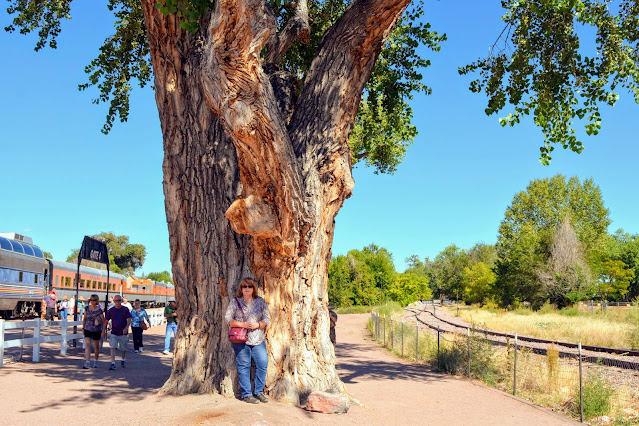To My Email Subscribers: Beginning July 1, 2021, the Blogger e-mail Feedburner subscription service will be turned off. Therefore, you will no longer receive emails when a new post is published at Mille Fiori Favoriti. I offer you the alternative of joining Bloglovin and subscribing to follow Mille Fiori Favoriti there. You will then receive emails when I publish a new post.
Alternatively, you can also make a note of my blog's URL: https://millefiorifavoriti.blogspot.com
and then check weekly, usually on Mondays, for a new blog post.
I hope you will use one of these alternatives. Thank you for reading my blog, published since 2007! I look forward to seeing all of you here at Mille Fiori Favoriti
A lovely Cottonwood tree in a local park gives beauty and shade. There’s a type of Cottonwood tree for nearly any region, with different hardy types in Zones 2 through 9. The Kansas Legislature designated Cottonwood as the State Tree in 1937, calling it the "pioneer tree of the prairie." Here in Colorado they are one of the largest native broadleaf trees found along the front range
What else do Cottonwood trees give us this time of the year?
They give us lots and lots of cotton-like seed fluff, flying in the air like downy snow!
Perhaps because we had a lot of rain this spring or the weather became very warm all at once, there seems to be more Cottonwood fluff than ever this season. It has been coating the ground in many areas and...
Covering my clothes as I sit in the parks watching my grandson play Little League baseball.
Like willows, cottonwoods have separate male and female trees. In late winter, the cottonwood’s reproductive season begins. The male and female trees each produce dangling catkins. Pollen from the male trees is transferred to the female pistillate catkins by wind.
Leaf buds appear on cottonwood trees in the late winter or early spring. The air becomes redolent with the scent of bud scale resin. Leaves appear, then later in the spring, the seeds ripen and capsules split on the female trees to release a snowfall of cotton-coated seeds.
Members of the Poplar family, cottonwoods were important to Native Americans who used all parts of the tree. The bark provided forage for horses and a bitter, medicinal tea for their owners. Sweet sprouts and inner bark were a food source for both humans and animals. The Cottonwood tree trunks became canoes.
Many parts of the cottonwood tree are medicinal. A compound called salicin, which is found in the leaves, buds, and bark of cottonwood, has been proven to lower fevers and reduce inflammation and pain. The resin has been used to waterproof boxes and baskets, and the bark has been used to make buckets for storing and carrying food. Cottonwood wood was important in the 1800s and 1900s for making paper, boxes and crates, packing material, sugar barrels, and kitchen utensils.
A cottonwood tree can grow 6 feet (2m) in one year! It can grow to be more than 100 feet tall and almost as wide. In the wild, cottonwood grows along rivers, ponds, and other bodies of water. It also thrives in floodplains and dry riverbeds, where infrequent rains transform dry land into waterways.
Many parts of the cottonwood tree are medicinal. A compound called salicin, which is found in the leaves, buds, and bark of cottonwood, has been proven to lower fevers and reduce inflammation and pain. The resin has been used to waterproof boxes and baskets, and the bark has been used to make buckets for storing and carrying food. Cottonwood wood was important in the 1800s and 1900s for making paper, boxes and crates, packing material, sugar barrels, and kitchen utensils.
Their rapid growth is also a negative, because the wood is brittle, leading to breaking branches. As you can see in the photo above this Cottonwood tree was rotting from within and had to be cut or else it may have eventually collapsed and caused damage.
An eagle pair was nurturing an eaglet this spring in Colorado's Standley Lake, and the eagles' nest was on a webcam, attracting thousands of viewers. One day the nest, indeed the tree, was gone! It turns out the Cottonwood tree supporting the nest split in half and the tree and nest fell. Sadly, the eaglet did not survive, but happily, the Eagle pair made a new nest on another tree and there is hope new eaglets will hatch.
The Cottonwood tree is an asset in wildlife areas where its hollow trunk serves as shelter while the twigs and bark provide food. Beavers use cottonwood for food and building materials. Deer eat leaves and twigs. Native butterflies, including the larvae of western tiger swallowtail, Lorquin’s admiral, Persius duskywing, and many kinds of moths, feed on cottonwood. Cottonwood resin is called “bee glue” because bees gather it to seal up their hives to protect them from invading insects and microbes. It is an ingredient in propolis. Roosting turkeys eagles and other birds live in them.
In autumn the Cottonwood tree's leaves turn golden yellow and add beauty to the fall.
One of the most amazing Cottonwood trees I've come across since moving to Colorado was at the Royal Gorge Route Railroad! Look at the size of its trunk! We could not get the entire tree in the camera lens it was so very tall. If you like to read about this very scenic train ride click here.
Wishing everyone a Happy First Day of Summer and a Happy Fathers' Day!



































41 comments:
Pat - first, thanks for your intro paragraph - I need to notify my email subscribers about this!
A terrific post about the cottonwood. Sometime ago I had read that it is one of the trees favored by eagles for their nests, and that declining populations of the trees have caused nesting issues for our national bird ...
It is amazing how one tree is so crucial to the ecosystem in so many ways. Thanks for linking to Mosaic Monday!
Gorgeous photos. Happy Monday
Much💛love
Hello Pat,
Great post and info on the Cottonwood trees. It was sad to hear about the loss of the Eagle's nest and the tree. The deer are so pretty, I always enjoy seeing them. Take care, have a happy new week!
I enjoyed learning more about the Cottonwood tree. Have a great week.
Wow! That's a huge tree and I've loved seeing photos of it in it's Fall splendor! How amazing to see the fluff along the road too. Enjoy your day. I went on that train years ago! Would love to again!
Wow...look at the size of that last one! That's incredible! We don't have those trees here. They are beautiful and indeed grow fast. Nice photos!
I've never seen these, and it's easy to tell how they got their name!
Thanks for sharing at https://image-in-ing.blogspot.com/2021/06/mmmm-magnolia.html
Happy Summer to you too Pat! I certainly didn’t know all those good things about cottonwood trees although I sure remember the “snow” from them. One time when we visited Colorado I thought it actually had snowed because the street was so covered with that fluff.
Well, now I know much more about the tree that blows fluff all about! Thanks for that! (I left my car windows open the other day when visiting a friend and came back to a front seat full of fluff!)
Cottonwoods were prolific in the areas around Dallas, TX. Then came all the growth. Now more streets named cottonwood it seems. Thanks, again for sharing the Colorado beauty.
I love cottonwood trees. They seem to grow all over the west and the midwest. I love how the leaves shimmer at the slightest hint of wind.
interesting post - decades ago my sister bought a house with one by the drive - unfortunately she was allergic to it and had it removed.
Thank you, Pat for all the interesting facts on the cottonwood tree! When we walk the Heritage Trail we get that "snow" on us like you did with your grand. The last tree you featured is a beauty! Happy summer days ahead!
What a nice interesting post and photos thanks for sharing :-)
Have a treetastic week 👍
We have a lot of cottonwood trees in Texas! Using along streams, creeks and rivers. We happen to have a HUGE in the backyard of the house behind us! Reason? It's growing in the swimming pool area that was filled up years ago!
I love seeing your photos of Colorado! My favorite state next to Texas! It's much prettier than Texas in my opinion....
Those Cottonwoods are huge. I like them, all except the fluff filling the air during a short time in spring.
I enjoyed reading this post about the Cottonwood trees.
Many thanks for all the photographs too.
Nice to watch your grandson at Little League Baseball :)
Have a good week ahead.
All the best Jan
We have many Cottonwoods here too. Not good for firewood so we leave them in our woodlot. Interesting post
MB
That was a very informative and interesting post. Amazing how many uses one tree has.
That's a good idea sending them to Bloglovin! I tried installing follow.it but can't see how it generates an email.
What an interesting post about the cottonwood tree. I knew some of that information, but I learned a lot, too. Now I have to find out if there are cottonwoods in my area of the US.
wow that's a lot of fluff.. thanks for all the info. Sounds interesting.
I'd never heard of cottonwoods. Very interesting!
I'd never heard of cottonwoods. Very interesting
beautiful images and informative post.
Thanks for the notice about feed burner. I got these notices but ignored them, and now I know I should pay more attention to such things. Second, thanks for all the info on the cottonwood tree, a tree I knew nothing about.
I love them for their size. I have a pair I call, "the twins" that I always marvel at, along a path I take often. Informative!
6 Feet in one year?? That's pretty amazing! What a neat tree.
...cottonwoods may be a desirable in some parts of the country, here they are weeds!
So interesting!
They are beautiful trees, but they do make me sneeze. A wonderful and informative post. Thanks for linking up.
Wow! The last tree is huge and old.
Beautiful pictures and informative walk through
Top shot.
Greetings and Salutations! I enjoyed learning about cottonwood trees. Lovely photographs.
Great to have you comment on my blog again ` missed you ~ Wonderful post and photos about the magnificent cottonwood tree ~ Xo
Living in the moment,
A ShutterBug Explores,
aka (A Creative Harbor)
I love relaxing under the shade of a cottonwood. They grow in the desert when their roots can reach water. On my last hike a couple days ago I saw a ton of cottonwood "fluff"!
What would the West be without cottonwoods? You've found some stately ones. Thanks!
I've heard about cottonwood trees but have never actually seen one, so thanks for that.
It's nice to see your link this week at 'My Corner of the World'!
I enjoyed reading about this tree, we don't have cottonwoods over in the UK. What a shame for that poor eaglet!
I often listen to the minimalist podcast. Thanks for sharing this at the Friday with Friend link party.
Post a Comment